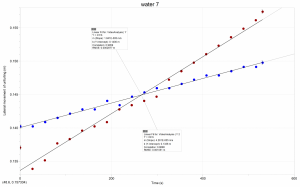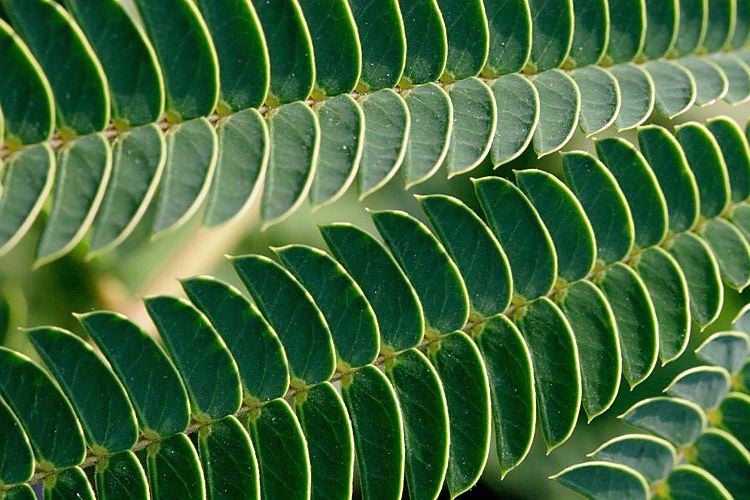Abstract: The Mimosa pudica plant is named the “Bashful Mimosa” because of its notable reaction to touch and other stimuli. Most people think of plants as organisms that don’t move very much… or at all. However, Mimosa plants show that this is false. Mimosa plants close their leaves to protect themselves from the harm. When the plant experiences dark, wind, heat, or touch the leaves fold inwards and the branches collapse. These stimuli are called seismonastic movements. There have been many experiments that show that once the plant has been subject to a certain stimuli for enough times, the plant will stop reacting. This is an evolutionary trait that helps the plant learn what kind of things are actually helpful and not harmful to the plant. Finding this very interesting we decided to explore this idea further. For our research project we exposed Mimosa plants to water and air to see how fast their recovery time would be. Does the number of times a mimosa plant is subject to a certain stimuli affect the plant’s recovery time? If we use a pipette to blast water and a fan to blast air onto the plant at certain intervals, then the recovery time of the plant to its original position will vary because the cells will need different amounts of time to reform their vacuoles based on the stimulus used.
Introduction: As we research different aspects of plants to find something interesting we came across thigmonastic movement. We found that few plants actually have this kind of movement and that the most fascinating is the Mimosa pudica. One of the first people to investigate the Mimosa plant’s movement was Robert Hooke. He believed that the Mimosa plant’s had nerves and tissues very similar to animals because they reacted to stimulus by closing their leaves. Later it was discovered that the leaves actually fold as a result of the internal movement of water. Instead of using muscles or a brain, plants move in different ways. The Mimosa plant’s reaction to triggers is what is known as a “sleep” state. This state is a form of nyctinastic movement. A stimulus, such as touch or air movement, triggers certain areas of the stem to release chemicals, which cause water to move out of cell vacuoles and leads to cell collapse (Kew.org). This led us to want to research further into this unique movement that the plants experience.
As we researched further we learned that Mimosa plants adapt to certain aspects of their surroundings and eventually they stop reacting to non-dangerous triggers all together in order to save energy. We believe that when we trigger the plant’s reaction with water and air, the recovery time of the plant will vary because the cells will need different amounts of time to reform their vacuoles based on the stimulus used.

One scientist by the name of Monica Gagliano designed an experiment to test whether or not the mimosa plant could become accustomed to a stimuli that proved harmless (Krulwich). In her experiment, she dropped the plant from a height that would not cause the mimosa plant any damage at five second intervals. She noticed throughout her experiment that parts of the plant stopped folding its leaves upon impact. Her results were that after a certain amount of drops the plants stopped reacting completely to the impact. Then Gagliano put the same plants in a shaking device, where they again reacted to the new stimulus. This shows that the Mimosa plants learn about their environment and can respond to harmful and harmless stimuli in different ways. Gagliano repeated the dropping experiment every week for 28 days and the plants still remembered that the drop was harmless and did not react.
Reading about this experiment gave us the idea to take it further and test the recovery time of the plants in between triggers. We wanted to know how long it took for the Mimosa to recover based on how many times it had been subject to either water or air stimuli.
Methods: For our experiment we obtained five Mimosa plants and split them into 3 groups. One was our control group, one was subject to water stimuli and the other was subject to air stimuli. We used spray bottles to distribute water on the leaves of the Mimosa plant in group two. We sprayed about two squirts on each plant to make sure all the leaves are wet and therefore react to the stimuli. We found out the weight of one squirt of water by placing a piece of paper on a scale and then squirting water on it. Then we time how long it takes for all the leaves to uncurl and to fully recover. We repeated this step multiple times until the plant stopped reacting. We then took group three and distributed air among them by a fan. We found the air pressure of the fan by looking up the model on the internet. The last plant was our control group so we left it alone for our experiment. We used a cell phone mounted on a tripod to record this experiment for video analysis. In the video we made sure to include a metric stick so we could have a scale for the video analysis. We also had LoggerPro to review our video and analyse our data. We researched how to care for Mimosa plants in order to keep them healthy. We kept them under T-8 lights for 8 hours per day. The soil was kept moist but not soggy and the temperature stayed above 65 degrees Fahrenheit. We also kept a humidifier going throughout the day.

Results: After hours of research we came to the conclusion that after many repetitions of the same action the Mimosa plant would unfurl quicker than in the beginning. We concluded that our hypothesis was correct because the stimuli seemed to have an effect on how quickly the plant recovered. Just like we read beforehand, it appeared that after a certain amount of repetitions the plant begins to understand that it shouldn’t waste energy keeping their leaves furled when the action is harmless to the plant. This is why after about 20 repetitions the plant learns that the water and air is part of its environment and will not hurt the plant. Though this was almost half of the repetitions Monica Gagliano did we noticed the plants beginning to stop reacting. We conclude that this is because we are using familiar forces such as water and air that the plant was already somewhat familiar too. Though we used a greater force of water and air than what the plant is used to.

Discussion: Overall, we loved working with the Mimosa plants. It is very neat to see them curl and move. What is also very cool about the Mimosa plant is that is somehow learns about its surroundings and the environment it is in. Many articles have been written about the learning capabilities of the Mimosa plant and we were able to see it first hand with these plants. After a while, the plants stopped reacting to even the biggest pressures we gave them because they were used to it. Some of our sources of error was definitely our original project. We wanted to do sundew plants regarding their feeding habits but that ended up not working out because our plants began to die. So in week 8 we had to change our research project and that has caused a lot of rushing. We feel like we communicated well and that everyone did their part and understood what was going on. Everyone took their responsibilities seriously and we just had bad luck with our original plants. However, we bounced back and had a great time with the Mimosa plants.
Works Cited
“How to Grow and Care for the Sensitive Plant in Containers.” How to Grow and Care for the Sensitive Plant in Containers. Joomal, n.d. Web. 23 May 2016.
Krulwich, Robert. “Can a Plant Remember? This One Seems To-Here’s the Evidence.” Phenomena Can a Plant Remember This One Seems ToHeres the Evidence Comments. National Geographic, 15 Dec. 2015. Web. 23 May 2016.
M, Gagliano. “Mimosa Plants Have Long Term Memory, Can Learn, Biologists Say | Biology | Sci-News.com.” Breaking Science News. N.p., 2014. Web. 19 May 2016.
“Mimosa Leaf.” Mimosa Leaf. N.p., n.d. Web. 19 May 2016.
“Mimosa Pudica (sensitive Plant).” Royal Botanic Gardens, Kew. N.p., n.d. Web. 23 May 2016.
“Mimosa Pudica Linn.” SpringerReference (n.d.): n. pag. Web.
Volkov, Alexander G. Plant Electrophysiology: Theory and Methods. Berlin: Springer-Verlag, 2006. Print.

Be First to Comment